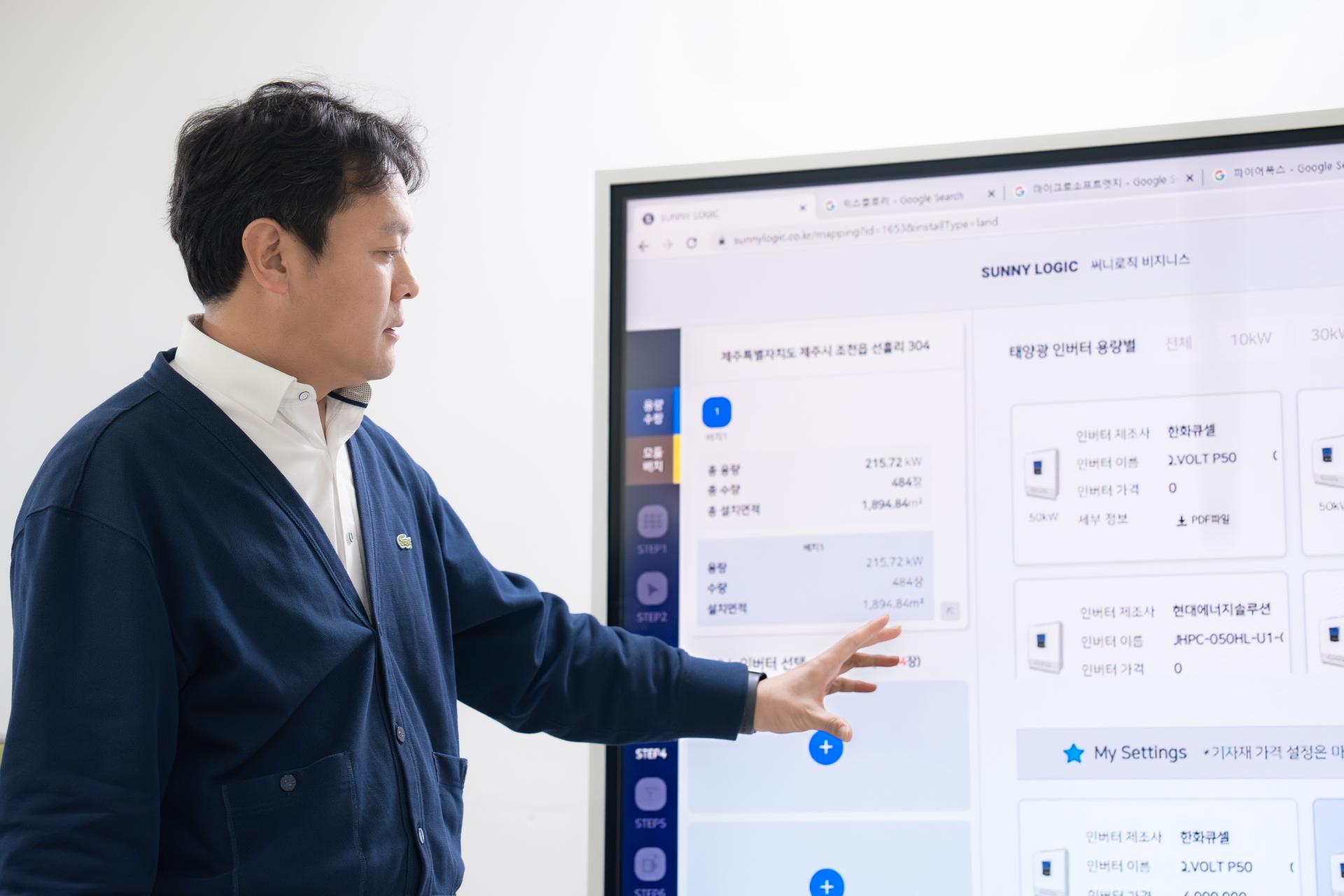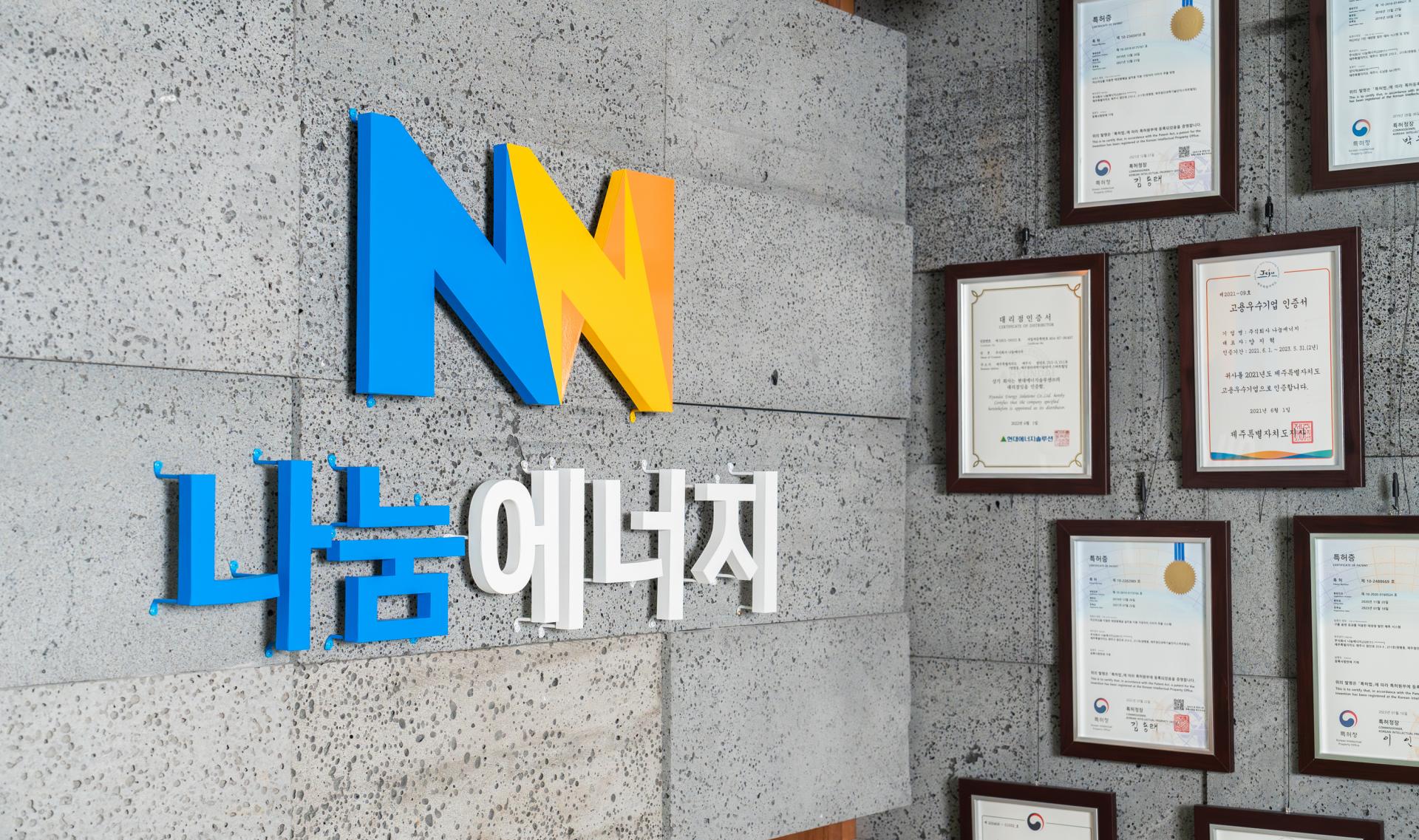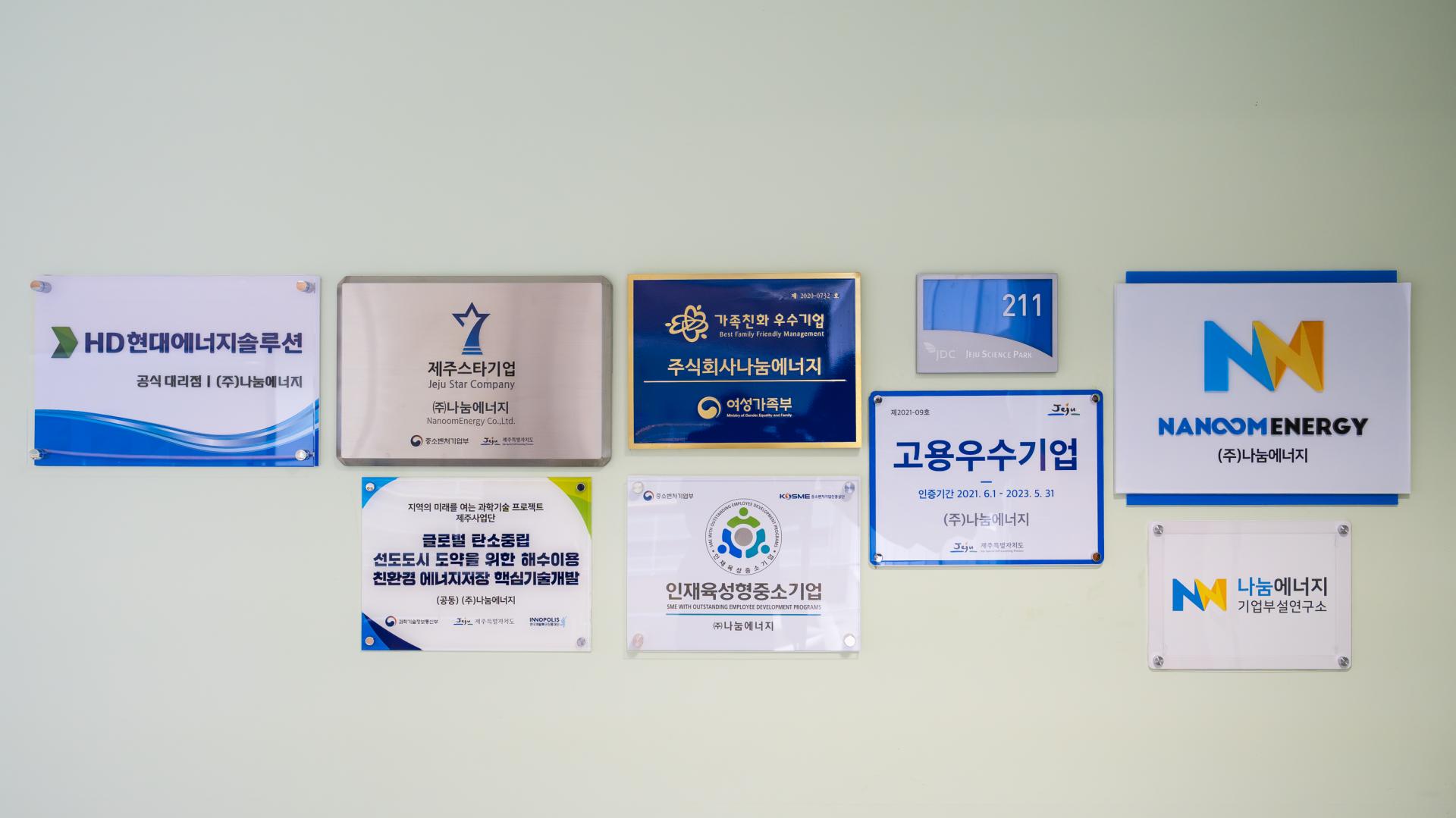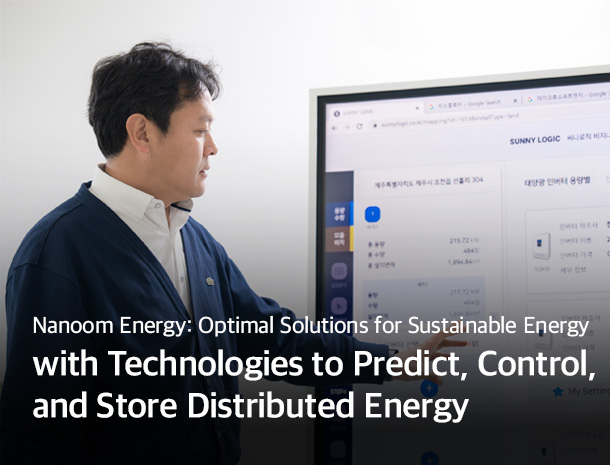Industry Trends
- Home
- Jeju Life
- Industry Trends

“I first came across a photovoltaic system for buildings when I won a solar energy competition as a third-year undergraduate. At that time, photovoltaic technology was still an unfamiliar concept in Korea, and I was drawn to the idea of houses and buildings producing their own power. After graduation, I worked at a photovoltaic company based in Seoul. Later, I moved to California, United States, and worked as an engineer at a local company for six years. In 2016, I returned to my hometown, Jeju, and founded Nanoom Energy. As I was born and raised in Jeju, the island was the perfect place for my new and renewable energy business. There were ample support and opportunities for collaboration with various local agencies and organizations, including the Jeju Special Self-Governing Province Government, Jeju Technopark, and Korea SMEs and Startups Agency. In addition, by launching the business in Jeju, I aimed to promote harmonious co-existence with the local community by boosting the local economy and creating jobs.”
Yang Jihyeok, CEO, Nanoom Energy
|
A global new and renewable energy company committed to promoting social values |
Founded in 2016, Nanoom Energy is a renewable energy solution provider based in Jeju, Korea. In its early years, the company focused on installing solar panels on houses and buildings. Recently, Nanoom Energy has expanded its operations to include the manufacturing and sales of solutions for operating and controlling software-based, new and renewable energy IT platforms. It is committed to providing the best solutions to promote the use of sustainable energy, making it easy for anyone to plan, produce, and use. Its steadfast R&D efforts and solid technical foundation enable it to continuously explore more efficient ways to supply eco-friendly energy. Nanoom Energy is recognized as one of Korea’s leading providers of information technology (IT) and environmental technology (ET)-based energy solutions. The company is dedicated to developing technologies for a sustainable future, supporting continuous R&D efforts, fostering global talent, creating social value, and protecting the environment. These commitments underscores its goal of achieving net zero and transitioning to green energy.


Q Could you give an overview of Nanoom Energy’s business and service offerings?
Nanoom Energy operates across four key businesses areas. The first area focuses on IT platforms for the development and operation of renewable energy, featuring products such as the RE100 solution SunnyLogic, the power resource operation platform Automon, and Energy Planner, our business-to-business (B2B) engineering service in the United States. The second area involves the development and supply of hardware, specifically power control systems (power optimizers). The third area includes R&D projects in collaboration with public agencies and partner companies, focusing on emerging technologies. Lastly, since our inception, we have specialized in the planning, design, and installation of comprehensive one-stop photovoltaic systems.
Q Given that most of your business is B2B, how do your energy services influence our daily experiences?
Electricity is essential for our daily routines, powering everything from small lights and appliances to the information and communication technology (ICT) equipment that is integral to our lives. It also runs our heating and cooling systems and various modes of transportation, such as cars, buses, and trains. A reliable electricity supply is crucial not only for comfortable living but also for maintaining a safe environment. Energy businesses play a key role in addressing the climate crisis by promoting sustainable energy practices that minimize environmental impact, manage waste, and reduce air pollution.

|
Promoting wider use and efficient supply of eco-friendly energy |
Q I heard that you install optimizers in individual modules of your new and renewable energy systems to monitor power production and control the systems in real time. Can you tell us more about it?
Today, most photovoltaic power plants use structures comprised of serially connected modules. If even one of the connected modules loses performance, it may affect all the modules and cause output loss. In our system, when an output imbalance occurs between modules due to uneven lighting caused by dust, shade, snow, or other factors, the optimizer reduces the effects of performance deviations and degradation to increase power generation. In this way, the optimizer helps power plants reduce losses and optimize the efficiency of energy production by preventing output losses in advance. Optimon, the optimizer we developed at Nanoom Energy, uses patented technology powered by machine learning and a distributed maximum power point tracking (MPPT) algorithm to detect and control the causes of module output loss. With just 3% shading, the optimizer can improve power production efficiency by up to 20%. In addition, it comes with a communication system for real-time monitoring of each module, and an internal smart control program to quickly locate failures for easier maintenance. The Rapid Shutdown technology can shut down production within 30 seconds, further reducing the risk of fire.

Q What are new and renewable energy control solutions? On a related note, can you tell me about your power plants in Seongeup, Sehwa, and Mureung?
The new and renewable energy control solution is a system designed to address the output limitations caused by the intermittent nature of renewable energy supply and imbalances in power demands. This solution includes optimizers powered by Nanoom Energy's patented technology, which has been widely recognized for its technical excellence, including its designation as an Outstanding Product by the Korean Public Procurement Service. With the upcoming launch of the Special Act on Distributed Energy this June, we expect to play a central role in the distributed energy market on Jeju Island. We aim to provide critical energy control and prediction/storage solutions, which are core technologies for the distributed energy sector.


Q You said that, unlike thermal power plants, prediction is crucial for renewable energy because of its high volatility, such as seasonal changes. Can you tell us more about it?
In a time characterized by climate change and the transition to renewable energy, failing to respond to volatility may result in large-scale blackouts. To prevent these incidents, Nanoom Energy utilizes machine learning and data analytics to predict energy production. We accurately predict short-term, medium-term, and long-term production to effectively respond to volatility. The technology collects and analyzes information related to power generated by photovoltaic systems and wind turbines in real time, which we expect to be used as an RE100 solution in the future. Our offerings in this area include SunnyLogic, which helps sales representatives at construction companies prepare profitability proposals, and SunnyMagic, which predicts power production and analyzes profitability for customers interested in building photovoltaic power plants.
Q Nanoom Energy has expanded its presence into global markets including the United States and Vietnam. I can only imagine the difficulties you must have experienced as a Jeju-based company trying to take on the global market.
Building on our engineering, procurement, and construction (EPC) businesses, Nanoom Energy is growing into a global new and renewable energy company by researching and developing core prediction, control, and storage technologies for distributed energy. In 2022, we proved our technological expertise and quality when our product was named an Excellent Product by the Korean Public Procurement Service. In 2023, we received a T3+ rating in a tech credit bureau (TCB) evaluation by Korea Rating & Data in recognition of our technical expertise, marketability, and business capabilities. Currently, we hold various technological patents at home and abroad, including 12 in Korea, two in the United States, two in Europe, and three in Australia. We strive for new opportunities and growth to overcome the limitations of being a locally based company in Jeju and to increase our competitiveness in the global market. In this regard, we have relied on various support projects from the provincial government and other administrative bodies such as the export voucher program and the support program for listed companies, which have been instrumental in our global expansion and marketing. With these programs, we are strengthening our competitiveness in the global market while pursuing continued growth.

|
The first step taken in Jeju, an island with pristine nature |
Q Many of your businesses are closely associated with Jeju, capitalizing on the region’s many benefits.
As the number of new and renewable energy facilities on Jeju Island increases, so do the output limits, implemented to prevent power grid overload. To address this issue, the Jeju government is working on plans to transfer surplus renewable energy produced on Jeju to the mainland and to install energy storage systems (ESS). Among the several ESS projects jointly carried out by the Jeju provincial government and the Korea Institute of Energy Technology, Nanoom Energy is researching and developing Environmental Monitoring Systems (EMS) for seawater energy storage management. EMS represents a large-capacity, ultra-long-cycle energy storage technology for the future, capable of safely and economically storing renewable energy using seawater. We aim to commercialize it by 2026. Since 2017, we have also participated in a government project for green home supply, promoting the use of new and renewable energy throughout Jeju Island. We strive to contribute to Jeju Island’s transition to eco-friendly energy by providing energy production systems and management solutions to local businesses and residents.


Q You have been working with various partners. Can you tell us about your collaboration with Jeju businesses?
We have collaborated with JE:US, a leading agricultural company in Jeju, as well as Aewol Papas, a local wellness farming cooperative. With support from the Jeju Free International City Development Center (JDC), we developed a wireless solar power source product for open-field environments for JE:US and installed them on citrus farms without electricity. With Aewol Papas, we have been working toward RE100 by launching a project to install new and renewable energy systems on the rooftops of poultry and livestock farms. We will actively pursue any other opportunities to collaborate with local businesses in the future.
Q I heard that you hired Jeju National University students as interns, later promoting them to full-time employees. Please tell us about your efforts to keep the company connected to the local community.
As a business deeply rooted in Jeju, we continuously seek ways to engage with and contribute to the local community, fostering mutual growth. To support this, we maintain regular contact with university professors and officials to enhance the educational and job opportunities available to students at Jeju National University. We have established and continually improve an annual internship program. Additionally, we launched an initiative that allows students to gain experience at our partner company in California, United States, further broadening their professional horizons.
Q What are the future plans and goals of Nanoom Energy, both in the short term and long term?
In the short term, our goal is to collaborate with various partners to lead the transition to sustainable energy using our existing distributed energy and RE100-related solutions, ensuring a stable energy supply and addressing the climate crisis. Over the long term, we aim to solidify our status as a leader in the energy sector through ongoing technological innovation and R&D projects, while maintaining the agility to adapt swiftly to market and technological changes. In addition, we are not satisfied with just our domestic achievements; we plan to expand our global footprint by increasing our presence in overseas markets, including through our branches in California, United States, and Ho Chi Minh City, Vietnam.

